CHEVROLET TRAVERSE 2009 1.G Owners Manual
Manufacturer: CHEVROLET, Model Year: 2009, Model line: TRAVERSE, Model: CHEVROLET TRAVERSE 2009 1.GPages: 422, PDF Size: 2.06 MB
Page 311 of 422
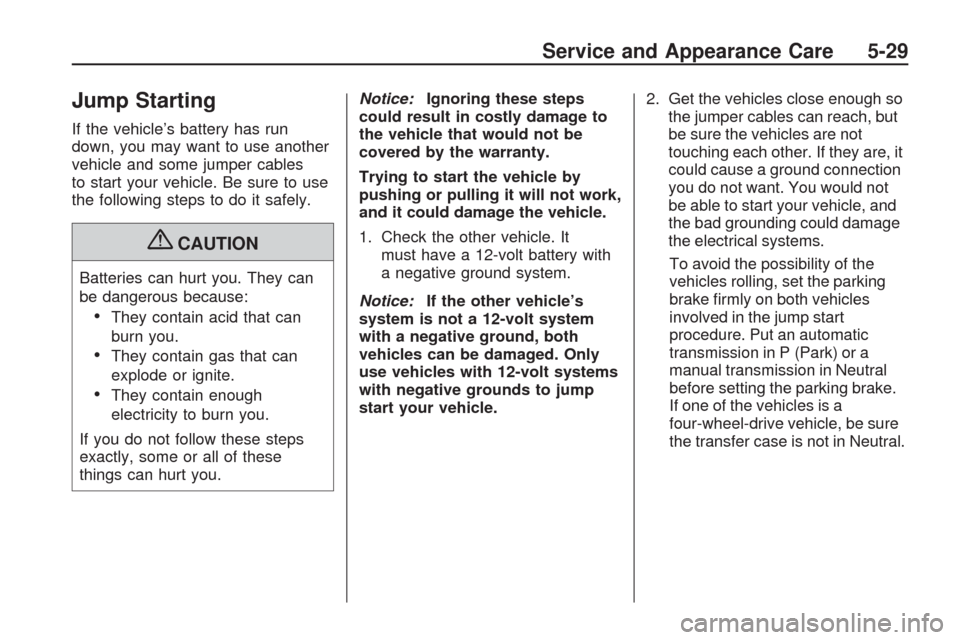
Jump Starting
If the vehicle’s battery has run
down, you may want to use another
vehicle and some jumper cables
to start your vehicle. Be sure to use
the following steps to do it safely.
{CAUTION
Batteries can hurt you. They can
be dangerous because:
They contain acid that can
burn you.
They contain gas that can
explode or ignite.
They contain enough
electricity to burn you.
If you do not follow these steps
exactly, some or all of these
things can hurt you.Notice:Ignoring these steps
could result in costly damage to
the vehicle that would not be
covered by the warranty.
Trying to start the vehicle by
pushing or pulling it will not work,
and it could damage the vehicle.
1. Check the other vehicle. It
must have a 12-volt battery with
a negative ground system.
Notice:If the other vehicle’s
system is not a 12-volt system
with a negative ground, both
vehicles can be damaged. Only
use vehicles with 12-volt systems
with negative grounds to jump
start your vehicle.2. Get the vehicles close enough so
the jumper cables can reach, but
be sure the vehicles are not
touching each other. If they are, it
could cause a ground connection
you do not want. You would not
be able to start your vehicle, and
the bad grounding could damage
the electrical systems.
To avoid the possibility of the
vehicles rolling, set the parking
brake �rmly on both vehicles
involved in the jump start
procedure. Put an automatic
transmission in P (Park) or a
manual transmission in Neutral
before setting the parking brake.
If one of the vehicles is a
four-wheel-drive vehicle, be sure
the transfer case is not in Neutral.
Service and Appearance Care 5-29
Page 312 of 422
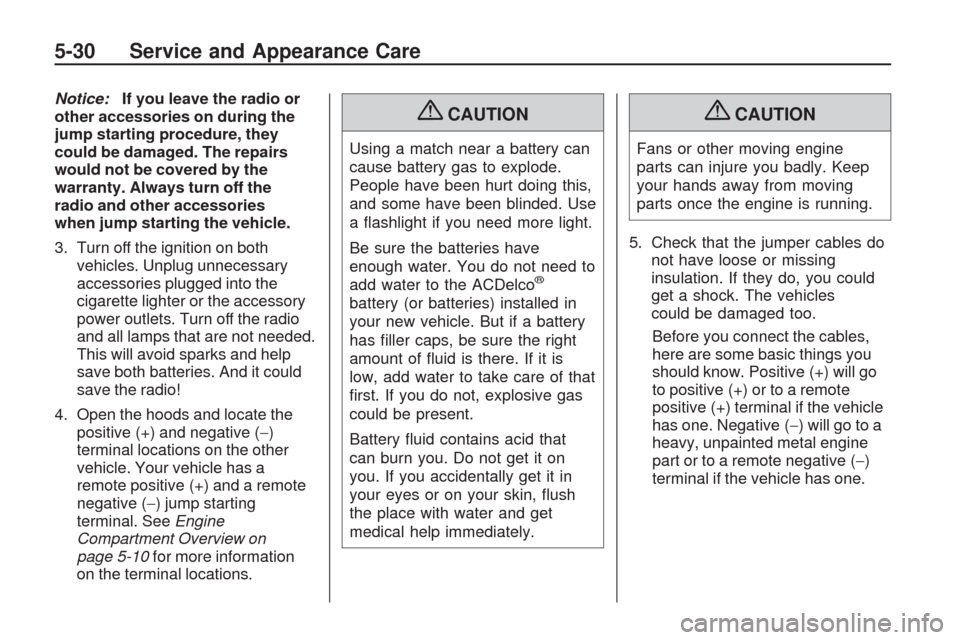
Notice:If you leave the radio or
other accessories on during the
jump starting procedure, they
could be damaged. The repairs
would not be covered by the
warranty. Always turn off the
radio and other accessories
when jump starting the vehicle.
3. Turn off the ignition on both
vehicles. Unplug unnecessary
accessories plugged into the
cigarette lighter or the accessory
power outlets. Turn off the radio
and all lamps that are not needed.
This will avoid sparks and help
save both batteries. And it could
save the radio!
4. Open the hoods and locate the
positive (+) and negative (−)
terminal locations on the other
vehicle. Your vehicle has a
remote positive (+) and a remote
negative (−) jump starting
terminal. SeeEngine
Compartment Overview on
page 5-10for more information
on the terminal locations.{CAUTION
Using a match near a battery can
cause battery gas to explode.
People have been hurt doing this,
and some have been blinded. Use
a �ashlight if you need more light.
Be sure the batteries have
enough water. You do not need to
add water to the ACDelco
®
battery (or batteries) installed in
your new vehicle. But if a battery
has �ller caps, be sure the right
amount of �uid is there. If it is
low, add water to take care of that
�rst. If you do not, explosive gas
could be present.
Battery �uid contains acid that
can burn you. Do not get it on
you. If you accidentally get it in
your eyes or on your skin, �ush
the place with water and get
medical help immediately.
{CAUTION
Fans or other moving engine
parts can injure you badly. Keep
your hands away from moving
parts once the engine is running.
5. Check that the jumper cables do
not have loose or missing
insulation. If they do, you could
get a shock. The vehicles
could be damaged too.
Before you connect the cables,
here are some basic things you
should know. Positive (+) will go
to positive (+) or to a remote
positive (+) terminal if the vehicle
has one. Negative (−) will go to a
heavy, unpainted metal engine
part or to a remote negative (−)
terminal if the vehicle has one.
5-30 Service and Appearance Care
Page 313 of 422
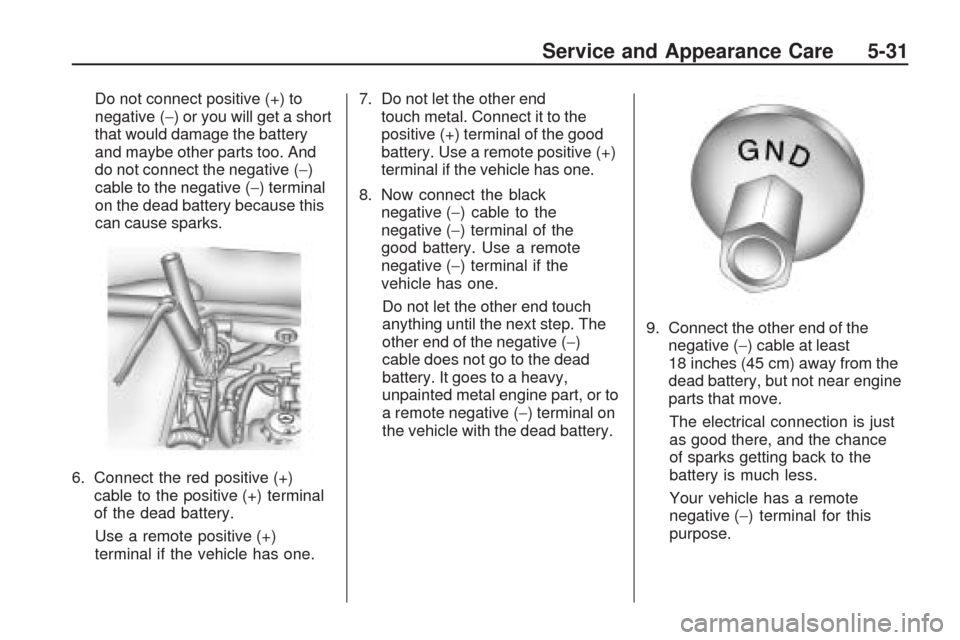
Do not connect positive (+) to
negative (−) or you will get a short
that would damage the battery
and maybe other parts too. And
do not connect the negative (−)
cable to the negative (−) terminal
on the dead battery because this
can cause sparks.
6. Connect the red positive (+)
cable to the positive (+) terminal
of the dead battery.
Use a remote positive (+)
terminal if the vehicle has one.7. Do not let the other end
touch metal. Connect it to the
positive (+) terminal of the good
battery. Use a remote positive (+)
terminal if the vehicle has one.
8. Now connect the black
negative (−) cable to the
negative (−) terminal of the
good battery. Use a remote
negative (−) terminal if the
vehicle has one.
Do not let the other end touch
anything until the next step. The
other end of the negative (−)
cable does not go to the dead
battery. It goes to a heavy,
unpainted metal engine part, or to
a remote negative (−) terminal on
the vehicle with the dead battery.9. Connect the other end of the
negative (−) cable at least
18 inches (45 cm) away from the
dead battery, but not near engine
parts that move.
The electrical connection is just
as good there, and the chance
of sparks getting back to the
battery is much less.
Your vehicle has a remote
negative (−) terminal for this
purpose.
Service and Appearance Care 5-31
Page 314 of 422
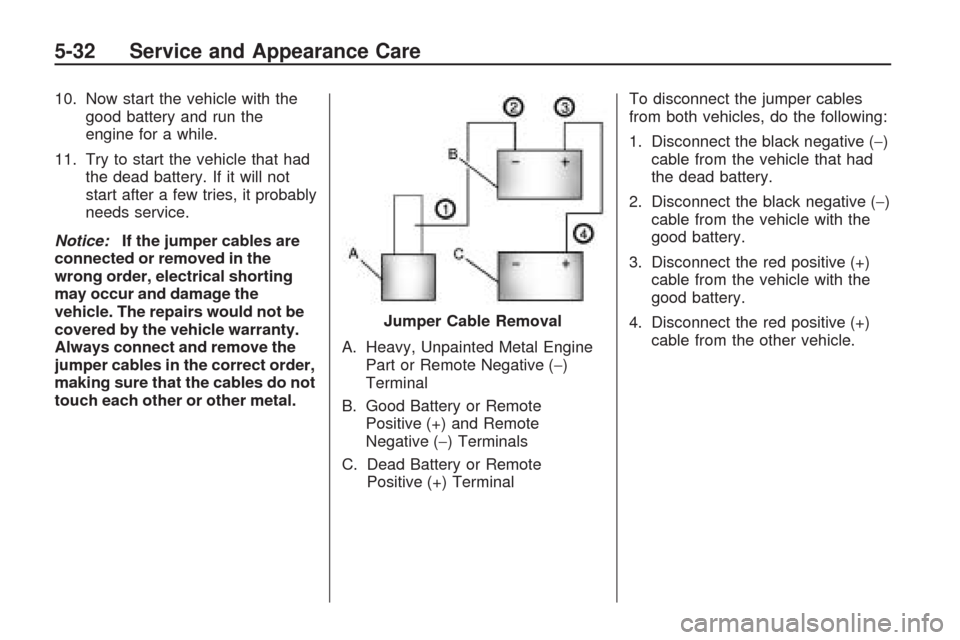
10. Now start the vehicle with the
good battery and run the
engine for a while.
11. Try to start the vehicle that had
the dead battery. If it will not
start after a few tries, it probably
needs service.
Notice:If the jumper cables are
connected or removed in the
wrong order, electrical shorting
may occur and damage the
vehicle. The repairs would not be
covered by the vehicle warranty.
Always connect and remove the
jumper cables in the correct order,
making sure that the cables do not
touch each other or other metal.A. Heavy, Unpainted Metal Engine
Part or Remote Negative (−)
Terminal
B. Good Battery or Remote
Positive (+) and Remote
Negative (−) Terminals
C. Dead Battery or Remote
Positive (+) TerminalTo disconnect the jumper cables
from both vehicles, do the following:
1. Disconnect the black negative (−)
cable from the vehicle that had
the dead battery.
2. Disconnect the black negative (−)
cable from the vehicle with the
good battery.
3. Disconnect the red positive (+)
cable from the vehicle with the
good battery.
4. Disconnect the red positive (+)
cable from the other vehicle. Jumper Cable Removal
5-32 Service and Appearance Care
Page 315 of 422
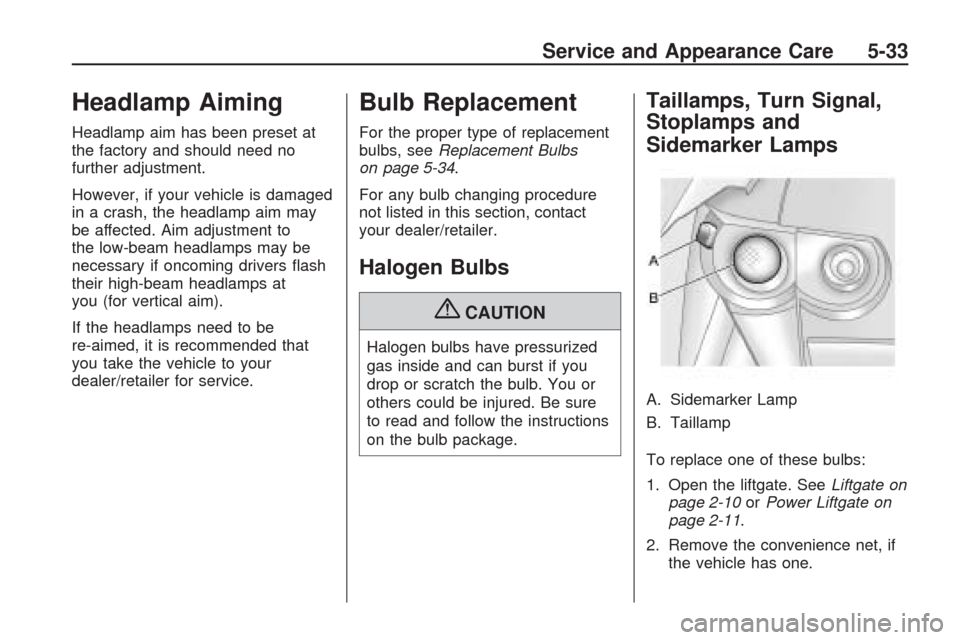
Headlamp Aiming
Headlamp aim has been preset at
the factory and should need no
further adjustment.
However, if your vehicle is damaged
in a crash, the headlamp aim may
be affected. Aim adjustment to
the low-beam headlamps may be
necessary if oncoming drivers �ash
their high-beam headlamps at
you (for vertical aim).
If the headlamps need to be
re-aimed, it is recommended that
you take the vehicle to your
dealer/retailer for service.
Bulb Replacement
For the proper type of replacement
bulbs, seeReplacement Bulbs
on page 5-34.
For any bulb changing procedure
not listed in this section, contact
your dealer/retailer.
Halogen Bulbs
{CAUTION
Halogen bulbs have pressurized
gas inside and can burst if you
drop or scratch the bulb. You or
others could be injured. Be sure
to read and follow the instructions
on the bulb package.
Taillamps, Turn Signal,
Stoplamps and
Sidemarker Lamps
A. Sidemarker Lamp
B. Taillamp
To replace one of these bulbs:
1. Open the liftgate. SeeLiftgate on
page 2-10orPower Liftgate on
page 2-11.
2. Remove the convenience net, if
the vehicle has one.
Service and Appearance Care 5-33
Page 316 of 422
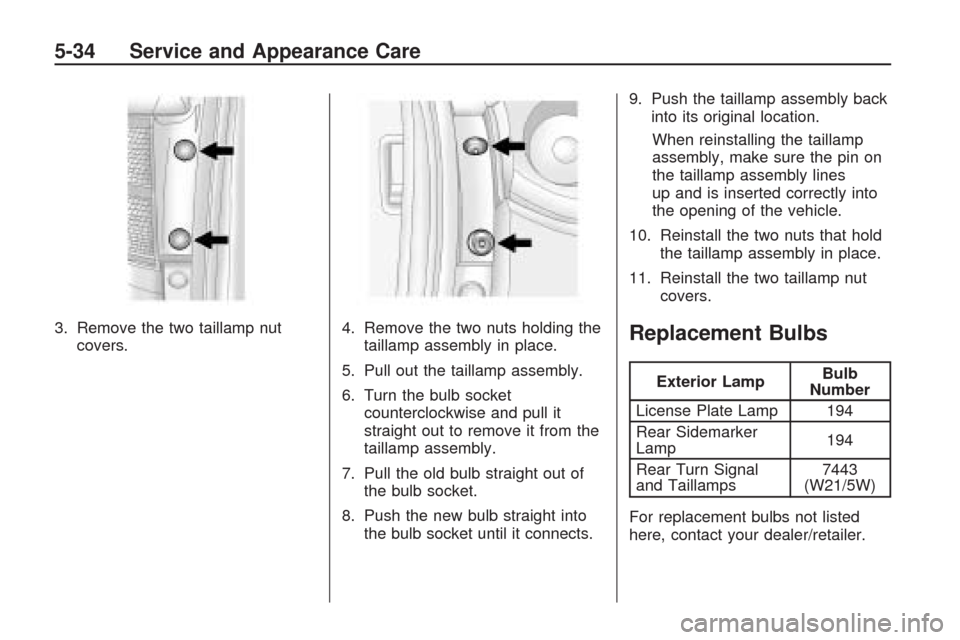
3. Remove the two taillamp nut
covers.4. Remove the two nuts holding the
taillamp assembly in place.
5. Pull out the taillamp assembly.
6. Turn the bulb socket
counterclockwise and pull it
straight out to remove it from the
taillamp assembly.
7. Pull the old bulb straight out of
the bulb socket.
8. Push the new bulb straight into
the bulb socket until it connects.9. Push the taillamp assembly back
into its original location.
When reinstalling the taillamp
assembly, make sure the pin on
the taillamp assembly lines
up and is inserted correctly into
the opening of the vehicle.
10. Reinstall the two nuts that hold
the taillamp assembly in place.
11. Reinstall the two taillamp nut
covers.Replacement Bulbs
Exterior LampBulb
Number
License Plate Lamp 194
Rear Sidemarker
Lamp194
Rear Turn Signal
and Taillamps7443
(W21/5W)
For replacement bulbs not listed
here, contact your dealer/retailer.
5-34 Service and Appearance Care
Page 317 of 422
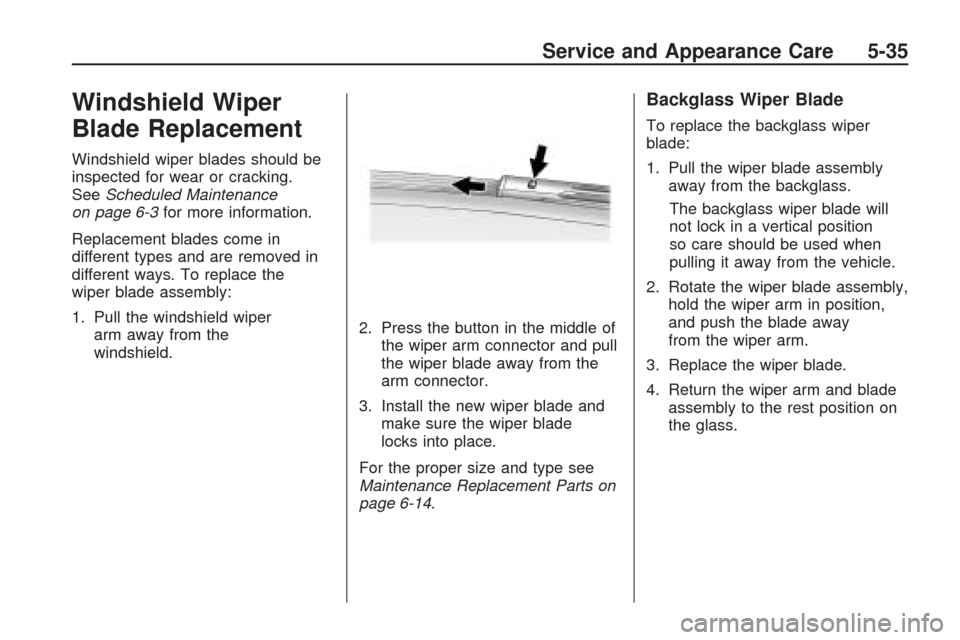
Windshield Wiper
Blade Replacement
Windshield wiper blades should be
inspected for wear or cracking.
SeeScheduled Maintenance
on page 6-3for more information.
Replacement blades come in
different types and are removed in
different ways. To replace the
wiper blade assembly:
1. Pull the windshield wiper
arm away from the
windshield.2. Press the button in the middle of
the wiper arm connector and pull
the wiper blade away from the
arm connector.
3. Install the new wiper blade and
make sure the wiper blade
locks into place.
For the proper size and type see
Maintenance Replacement Parts on
page 6-14.
Backglass Wiper Blade
To replace the backglass wiper
blade:
1. Pull the wiper blade assembly
away from the backglass.
The backglass wiper blade will
not lock in a vertical position
so care should be used when
pulling it away from the vehicle.
2. Rotate the wiper blade assembly,
hold the wiper arm in position,
and push the blade away
from the wiper arm.
3. Replace the wiper blade.
4. Return the wiper arm and blade
assembly to the rest position on
the glass.
Service and Appearance Care 5-35
Page 318 of 422
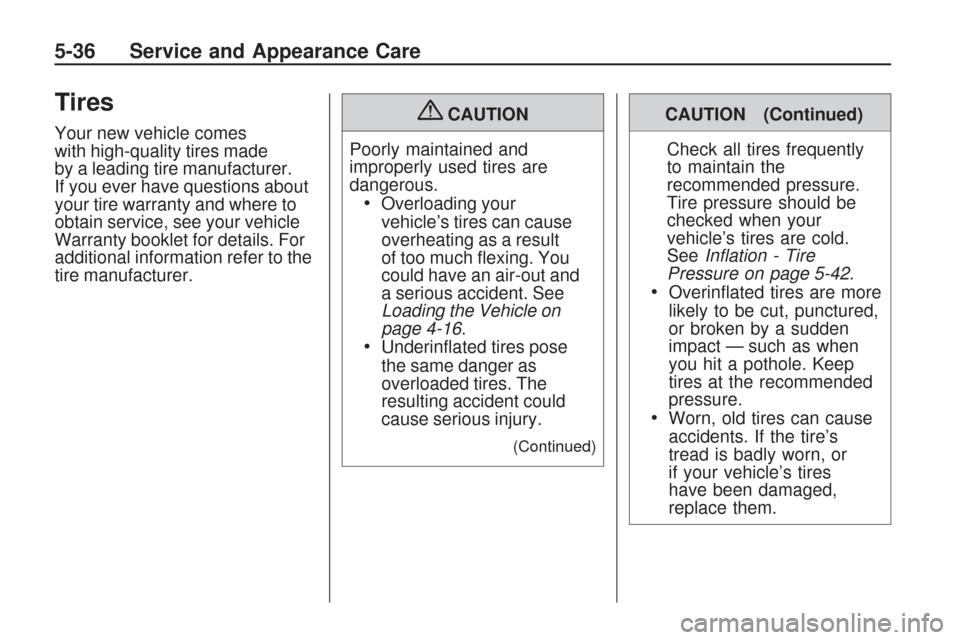
Tires
Your new vehicle comes
with high-quality tires made
by a leading tire manufacturer.
If you ever have questions about
your tire warranty and where to
obtain service, see your vehicle
Warranty booklet for details. For
additional information refer to the
tire manufacturer.
{CAUTION
Poorly maintained and
improperly used tires are
dangerous.
Overloading your
vehicle’s tires can cause
overheating as a result
of too much �exing. You
could have an air-out and
a serious accident. See
Loading the Vehicle on
page 4-16.
Underin�ated tires pose
the same danger as
overloaded tires. The
resulting accident could
cause serious injury.
(Continued)
CAUTION (Continued)
Check all tires frequently
to maintain the
recommended pressure.
Tire pressure should be
checked when your
vehicle’s tires are cold.
SeeInflation - Tire
Pressure on page 5-42.
Overin�ated tires are more
likely to be cut, punctured,
or broken by a sudden
impact — such as when
you hit a pothole. Keep
tires at the recommended
pressure.
Worn, old tires can cause
accidents. If the tire’s
tread is badly worn, or
if your vehicle’s tires
have been damaged,
replace them.
5-36 Service and Appearance Care
Page 319 of 422
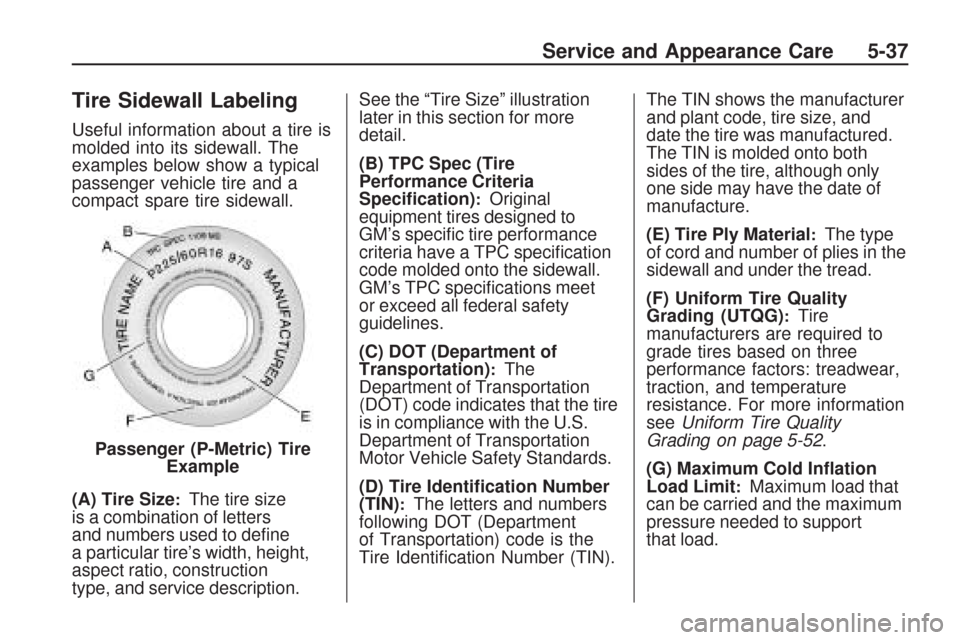
Tire Sidewall Labeling
Useful information about a tire is
molded into its sidewall. The
examples below show a typical
passenger vehicle tire and a
compact spare tire sidewall.
(A) Tire Size
:The tire size
is a combination of letters
and numbers used to de�ne
a particular tire’s width, height,
aspect ratio, construction
type, and service description.See the “Tire Size” illustration
later in this section for more
detail.
(B) TPC Spec (Tire
Performance Criteria
Speci�cation)
:Original
equipment tires designed to
GM’s speci�c tire performance
criteria have a TPC speci�cation
code molded onto the sidewall.
GM’s TPC speci�cations meet
or exceed all federal safety
guidelines.
(C) DOT (Department of
Transportation)
:The
Department of Transportation
(DOT) code indicates that the tire
is in compliance with the U.S.
Department of Transportation
Motor Vehicle Safety Standards.
(D) Tire Identi�cation Number
(TIN)
:The letters and numbers
following DOT (Department
of Transportation) code is the
Tire Identi�cation Number (TIN).The TIN shows the manufacturer
and plant code, tire size, and
date the tire was manufactured.
The TIN is molded onto both
sides of the tire, although only
one side may have the date of
manufacture.
(E) Tire Ply Material
:The type
of cord and number of plies in the
sidewall and under the tread.
(F) Uniform Tire Quality
Grading (UTQG)
:Tire
manufacturers are required to
grade tires based on three
performance factors: treadwear,
traction, and temperature
resistance. For more information
seeUniform Tire Quality
Grading on page 5-52.
(G) Maximum Cold In�ation
Load Limit
:Maximum load that
can be carried and the maximum
pressure needed to support
that load. Passenger (P-Metric) Tire
Example
Service and Appearance Care 5-37
Page 320 of 422
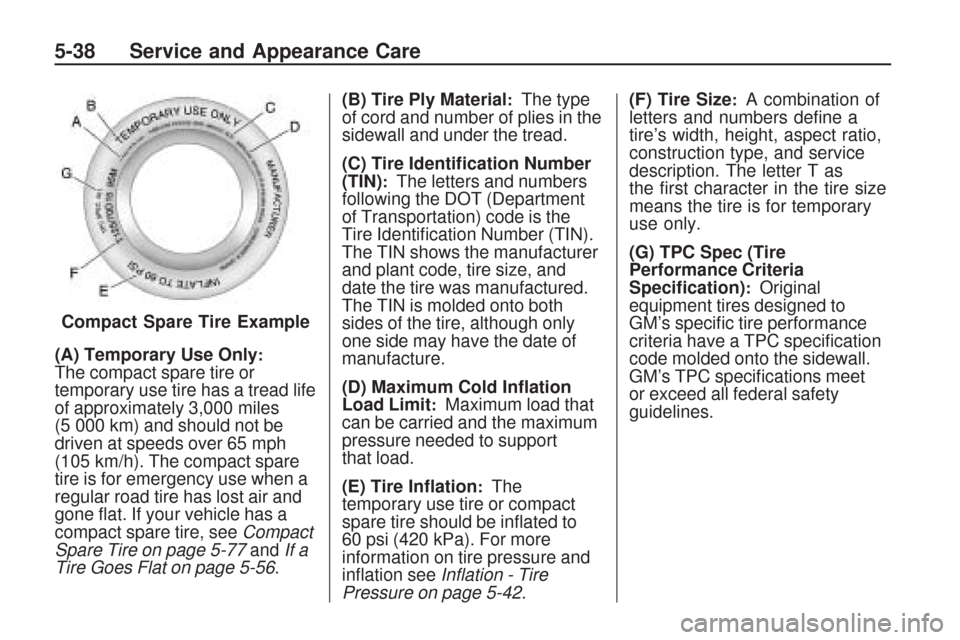
(A) Temporary Use Only:The compact spare tire or
temporary use tire has a tread life
of approximately 3,000 miles
(5 000 km) and should not be
driven at speeds over 65 mph
(105 km/h). The compact spare
tire is for emergency use when a
regular road tire has lost air and
gone �at. If your vehicle has a
compact spare tire, seeCompact
Spare Tire on page 5-77andIf a
Tire Goes Flat on page 5-56.(B) Tire Ply Material
:The type
of cord and number of plies in the
sidewall and under the tread.
(C) Tire Identi�cation Number
(TIN)
:The letters and numbers
following the DOT (Department
of Transportation) code is the
Tire Identi�cation Number (TIN).
The TIN shows the manufacturer
and plant code, tire size, and
date the tire was manufactured.
The TIN is molded onto both
sides of the tire, although only
one side may have the date of
manufacture.
(D) Maximum Cold In�ation
Load Limit
:Maximum load that
can be carried and the maximum
pressure needed to support
that load.
(E) Tire In�ation
:The
temporary use tire or compact
spare tire should be in�ated to
60 psi (420 kPa). For more
information on tire pressure and
in�ation seeInflation - Tire
Pressure on page 5-42.(F) Tire Size
:A combination of
letters and numbers de�ne a
tire’s width, height, aspect ratio,
construction type, and service
description. The letter T as
the �rst character in the tire size
means the tire is for temporary
use only.
(G) TPC Spec (Tire
Performance Criteria
Speci�cation)
:Original
equipment tires designed to
GM’s speci�c tire performance
criteria have a TPC speci�cation
code molded onto the sidewall.
GM’s TPC speci�cations meet
or exceed all federal safety
guidelines. Compact Spare Tire Example
5-38 Service and Appearance Care